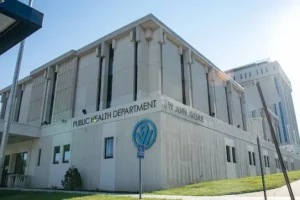United States: In recent weeks, an unsettling prevalence of two bacteria known to instigate pneumonia has been documented in Vermont and New Hampshire, culminating in heightened cases of respiratory infections.
At Dartmouth Hitchcock Medical Center (DHMC), a staggering 97 individuals afflicted with pneumonia sought emergency care between September and November—a dramatic rise from the 46 cases recorded during the same timeframe last year, according to Dr. Michael Calderwood, the hospital’s chief quality officer. While December’s data is still under review, preliminary indicators suggest a potential downturn in cases, according to Valley News.
Pneumonia, an infectious pulmonary condition marked by symptoms such as fever, chills, persistent coughing, labored breathing, lethargy, and thoracic discomfort, arises from an array of viral and bacterial pathogens, as per the Centers for Disease Control and Prevention (CDC).
Incidents of pneumonia have been on the rise in Vermont and New Hampshire this month. From @VNewsUV https://t.co/kDI9H7JY1G
— VTDigger (@vtdigger) December 25, 2024
Culprits Behind the Surge
The region has seen increased activity from two bacterial agents: Bordetella pertussis, the pathogen responsible for whooping cough—a highly transmissible respiratory malady that can progress to pneumonia—and Mycoplasma pneumoniae, a bacterium linked to walking pneumonia, a milder illness often devoid of the need for hospitalization or prolonged bed rest, Dr. Calderwood elucidated, according to Valley News.
In Vermont, outbreaks attributed to respiratory illnesses in schools have been connected to Mycoplasma pneumoniae, according to Laura Ann Nicolai, deputy state epidemiologist and senior infectious disease program manager. Some students received confirmed diagnoses of this infection, though not all cases underwent pathogen-specific testing.
Mycoplasma pneumoniae often manifests as a chest cold rather than full-blown pneumonia and primarily targets school-aged children, according to CDC data, which underscores its nationwide prevalence.
School Outbreaks and Health Advisories
Vermont’s Department of Health has cataloged seven respiratory illness outbreaks from school nurses, with individual outbreaks encompassing between five and 31 cases. A notable instance unfolded in a Windsor County school, Nicolai stated. On November 22, the department issued an advisory urging healthcare providers and school nurses to consider Mycoplasma pneumoniae in cases of pneumonia and to report clusters or unusual patterns of illness.
Broader Trends in Respiratory Illnesses
At Gifford Health Care, the incidence of pneumonia, influenza, and other respiratory viruses has remained within typical ranges, although infections among children have notably spiked, spokesperson Ashley Lincoln reported. Physicians have partly attributed this uptick to declining vaccination rates among younger populations, as reported by Valley News.
Decline in Childhood Vaccinations and Implications
A CDC study from September revealed that children born during the COVID-19 pandemic exhibited lower rates of routine vaccinations, including the pneumococcal vaccine recommended for children under 5. This vaccine, which guards against the most prevalent strain of pneumonia, does not provide immunity against walking pneumonia, for which no vaccine exists.
The pneumococcal vaccine is advocated for children under 5, adults over 50, and individuals at elevated risk for respiratory diseases. Vaccination against whooping cough relies on DTaP and Tdap vaccines, administered based on age-specific schedules.
Preventive Measures and Broader Health Implications
Pneumonia can also emerge as a secondary complication following respiratory infections such as the common cold, influenza, COVID-19, or respiratory syncytial virus (RSV), the American Lung Association notes. Vaccines against influenza, COVID-19, and RSV offer auxiliary protection against pneumonia, the CDC emphasizes.
To curtail disease transmission, individuals are advised to practice vigilant hand hygiene, remain at home when unwell, and, if concerned about safeguarding communal and personal health, consider wearing masks in public settings, Dr. Calderwood recommended, as per Valley News
By implementing these preventive measures and maintaining high vaccination rates, communities can mitigate the burden of respiratory illnesses and their cascading effects.





